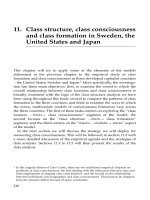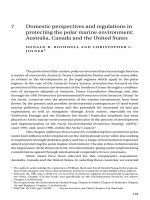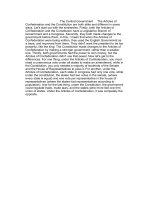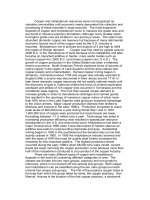Financial Reporting and the Business Environment: A Comparison of the United States and Mexico
Bạn đang xem bản rút gọn của tài liệu. Xem và tải ngay bản đầy đủ của tài liệu tại đây (155.67 KB, 71 trang )
AN ABSTRACT OF THE THESIS OF
Robert J. Wolfer for the degree of Honors Baccalaureate of Science in Accountancy
presented on August 23, 2007. Title: Financial Reporting and the Business Environment:
A Comparison of the United States and Mexico
Abstract approved: _________________________
Monica Banyi
Multinational corporations must be aware of the business and financial reporting issues
that await them abroad. Investors also must have this knowledge in order to adequately
interpret the financial information they receive from these companies. This study
compares and contrasts the business environments in the US and Mexico, with a focus on
financial reporting. The first section of this paper addresses cultural differences and their
impact on the business environment as well as business laws and practices specific to
each country. The second looks at the accounting standards of each country, as well as
international standards. Finally, a Mexican cement company, CEMEX, is used to show
how the accounting issues manifest themselves in practice.
Key Words: accounting, Mexico, international, standards
Corresponding e-mail address:
Financial Reporting and the Business Environment: A Comparison of the United States
and Mexico
by
Robert J. Wolfer
A PROJECT
submitted to
Oregon State University
University Honors College
in partial fulfillment of
the requirements for the
degree of
Honors Baccalaureate of Science in Accountancy (Honors Scholar)
Presented August 23, 2007
Commencement June 2008
Honors Baccalaureate of Science in Accountancy project of Robert J. Wolfer presented
August 23, 2007.
APPROVED:
Mentor, representing Accountancy
Committee Member, representing Accountancy
Committee Member, representing Accountancy
Chair, representing Accounting, Finance, and Information Management
Dean, University Honors College
I understand that my project will become part of the permanent collection of Oregon
State University, University Honors College. My signature below authorizes release of
my project to any reader upon request.
Robert J. Wolfer
Acknowledgements
First of all, I would like to thank Roger Graham, who started as my mentor. Even though
I could not retain him in the official capacity, he played the instrumental role in
overseeing my project.
I would also like to thank my committee. Professor Monica Banyi stepped in as the
official mentor on short notice and provided me with key advice. Professors Dennis
Caplan and Jared Moore, the other two members of my committee, also graciously gave
of their time during the summer to help see this project through.
Professor Raymond Brooks, chair of the Department of Accounting, Finance, and
Information management, also made significant contributions that strengthened the
quality of my project.
I would like to thank my immediate and extended family as well for all their
encouragement, support, prayer, and suggestions.
TABLE OF CONTENTS
Page
INTRODUCTION ……………………………………………………………………….. 1
BUSINESS AND CULTURE …………………………………………………………… 3
Hofstede’s Dimensions ….……………………………………………………….. 4
GLOBE Dimensions ….……………………………………………………….. 7
The Ugly American Syndrome..……………………………………………….. 4
Demographics ……….………………………………………………………….. 14
Government ………..………………………………………………………….... 15
Business Practices………………………………………………………………. 19
ACCOUNTING STANDARDS ……………………………………………………….. 26
Current Issues …………………………………………………………………... 26
Similarities and Significant Differences……………………………………….... 30
Taxation ………………………………………………………………………… 38
THE CEMENT INDUSTRY …………………………………………………………… 40
CEMEX Company Profile……………………………………...………………. 40
CEMEX and Financial Reporting……………………………………………….. 44
IMPLICATIONS AND CONCLUSIONS ……………………………………………... 54
BIBLIOGRAPHY ……………………………………………………………………… 56
LIST OF FIGURES
Figure
Figure 1: Hofstede’s Cultural Dimensions ………………………………………………………
Figure 2: U.S. and Mexican Inflation rates from 1975-2002 .. ...............................................
4
33
LIST OF TABLES
Table
Table 1: Employee Retention……………………………………………………………………………….24
Table 2: Changes to CEMEX stockholders’ equity in reconciliation to U.S. GAAP
Millions of constant Mexican pesos as of December 31, 2006 ……………………………………………49
Table 3: Adjustments to CEMEX net income to reconcile to U.S. GAAP
Millions of constant Mexican pesos as of December 31, 2006 …………………………………………….52
Financial Reporting and the Business Environment: A Comparison
of the United States and Mexico
When someone in the United States thinks of Mexico in relation to business, chances are
the issue of immigrant workers is the first idea that comes to mind. However, perhaps to
the surprise of many, our neighbor to the south is becoming a good place to do business
due to its relatively low corporate tax rates and inexpensive labor. When looking at a
foreign country as a potential place to do business, it is important to consider many
factors, one of which is accounting. The reason it is important to be knowledgeable
about the accounting practices in the two countries is that, due to globalization, and more
specifically to the North American Free Trade Agreement (NAFTA), capital is flowing
across the border in both directions.
Even though some consider it not far past the stage of developing country, Mexico does
have a sophisticated accounting system of its own and a national accountant society not
unlike our own AICPA. The country has its own thick books of accounting regulations
and pronouncements–called bulletins–just like our FASB pronouncements. However, it
does seem that Mexico’s accounting is not entirely independent of U.S. GAAP. The
Advanced Accounting course I took at the Technological Institute for Superior Studies at
Monterrey (ITESM) used the same textbook used in many universities around the United
States for the majority of its material. Because of the differences in the legal code, it was
also necessary to supplement the book with material specific to Mexico.
2
Before addressing the similarities and differences between the two countries with regard
to accounting, I would like to observe some key cultural and business differences because
of their importance to anyone doing business or investing in Mexico. I will do this by
using cultural dimensions from Hofstede and GLOBE, as well as looking at factors such
as government, demographics, and business practices.
In order to compare the accounting practices in both countries, I will talk about the
governing bodies in each nation and their responsibilities, as well as the Board
responsible for setting standards on an international level. My most critical source of
information will be a study done in 1994 and updated in 1998 by the accounting
standards boards in the U.S., Canada, and Mexico. I will also discuss taxation of
businesses because of its importance related to these issues.
After discussing the business environment and the accounting practices, I will use a large
Mexican cement company, CEMEX, as an example of the accounting practices for the
same company in two different countries. I first profile the company and discuss how
some of the issues from my first two sections relate to the company. My main sources of
information are annual reports and other forms filed with the U.S. Securities and
Exchange Commission.
3
Chapter 1: Business and Culture
When comparing the business environments of two countries, it is necessary to look at
the similarities and differences between the two cultures. This is because the business
environments in the two countries are heavily influenced by cultural norms. A country’s
culture shapes people’s actions, and these actions influence business practices and
decisions.
Mexico’s culture differs from that of the United States in many ways. Perhaps one of the
best ways to evaluate a nation’s culture for business purposes is to use Hofstede’s five
cultural dimensions (Hofstede 2003) or the nine GLOBE dimensions (Kinicki and
Kreitner 2006), which have been developed more recently. Two of the dimensions—
power distance and uncertainty avoidance—are common to both models, so I will look at
twelve dimensions altogether. It is important to remember, however, that while these
dimensions may characterize the country as a whole, they by no means characterize every
individual in the society described.
Hofstede’s Dimensions
Power Distance
Hofstede’s first dimension concerns unequal distribution of power within an
organization, which he calls “power distance.” An organization with high power distance
is characterized by those in higher positions having a disproportionate amount of power
4
compared to those below them. Mexican corporations are generally more hierarchical,
and subordinates are expected to act as such. In the U.S. there is more tolerance of
feedback and help with decision-making from lower-level employees.
Hofstede Cultural Dimensions
100
91
81
Rating
60
40
82
69
80
40
Mexico
62
U.S.
46
30
29
20
Long-Term
Orientation
Uncertainty
Avoidance
Masculinity
Individualism
Power
Distance
0
Figure 1: Hofstede’s Cultural Dimensions
Source: Hofstede 2003
Individualism
The United States is a very individualistic society in which it is very common for one
person to want to be the star. This is evidenced by the high CEO compensation in the
U.S. compared to Mexico and most other nations. (Business Week 2000). Many U.S.
firms make their CEO the star by paying him or her tens of millions of dollars while all
others receive significantly less. The American dream and picture of success in our
society is to get a high-paying job and be able to support an immediate family. As put by
historian James Truslow Adams, the society for this dream is one in which “each man
and each woman shall be able to attain the fullest stature of which they are innately
capable, and be recognized by others for what they are” (Jischke 2007). Many people
here also desire to attain a lot of power. In Mexico, by contrast, people are much more
5
concerned with being good family members, and this spills over into their business
practices. Success for one individual at the expense of the rest of the company is seen as
a failure. This is one reason why Mexican CEOs were paid 45 times the salary of their
employees on average (Wahlgren 2001) compared to 475 times in the U.S. (Business
Week 2000).
Masculinity
Mexico is known for its highly masculine culture, and for many, the term “Machismo”
comes to mind when this topic is brought up. One reason for this reputation is that
Mexican society is seen as one dominated by men–an issue I will discuss briefly later on–
and this is definitely true in the business world. However, this is not exactly the
definition of masculinity relating to Hofstede’s dimensions. He defines masculinity as a
culture displaying masculine values such as assertiveness, materialism, individual
achievements, and power. According to the scores given—see figure 1—Mexican
culture displays slightly more masculine characteristics than that of the United States.
Because the U.S. generally displays materialistic tendencies and has an individualistic or
assertive culture, the difference must be attributable to Mexican values relating to power.
Uncertainty Avoidance
As shown in figure 1, Mexican businesspeople are much more likely to avoid uncertainty
in business situations. This means they are less likely to take risks and are more
uncomfortable in uncertain circumstances. In the U.S., risk-taking is often applauded and
6
because of the size and complexity of our economy, we are forced to get used to dealing
with uncertainty on a regular basis. Mexican business culture demonstrates uncertainty
avoidance in numerous ways, as Schuler et al (1996) have observed in their article in
Business Horizons. One is that workers are generally closely supervised by their
superiors. Another is that their compensation methods tend to promote “consistency and
certainty,” meaning that workers are rewarded for staying with a company and for doing
a consistently good job. This contrasts with many jobs in the U.S., where managers and
directors use bonuses and incentives for employees that are more specifically focused on
financial targets.
Long-term Orientation
This dimension is the newest addition to Hofstede’s model, and it is also referred to as
Confucian Dynamism. Its main purpose is to account for ideological differences between
eastern and western cultures. Long-term orientation is often displayed by characteristics
such as persistence, a sense of shame, and having an order of relationships. By contrast,
short-term orientation is displayed by actions such as protecting one’s appearance and
reciprocating gifts. These are characteristic of U.S. culture, evidenced by many
Americans’ high level of concern regarding their image and the sense many in our culture
have that if one receives a gift, it should be reciprocated. Mexico has not yet been given
an index in this area; however, Mexico would most likely rate slightly higher regarding
long-term orientation because of its culture’s value placed on family and relationships.
My conjecture is that it would not be much higher because Mexican culture does show
some short-term characteristics such as that of reciprocating favors.
7
The GLOBE Dimensions
In 1994, a group of professors led by Robert House began a study into leadership theories
around the world. Their project was called the Global Leadership and Organizational
Behavior Effectiveness (GLOBE) project. While studying culture and leadership in 61
nations, the group developed a set of nine dimensions, some based on those of Hofstede
and some on the ideas of other researchers (House et al 2002). It could be argued that
these dimensions do a better job of comparing cultures than Hofstede’s model because
they build upon and add to it. The nine GLOBE dimensions are uncertainty avoidance,
power distance, societal collectivism, in-group collectivism, gender egalitarianism,
assertiveness, future orientation, performance orientation, and humane orientation. The
first two having been discussed above, I discuss the remaining seven below.
Societal Collectivism
This is the first of the GLOBE dimensions and relates very closely to the Hofstede’s
individualism dimension. Societal collectivism refers to how much loyalty to a social
unit is rewarded in the business environment. The characteristics of this dimension are
much more prevalent in Mexico than they are in the U.S. Here individuals are rewarded
for their personal performance, whereas in Mexico people are rewarded when the group
does well. This is also displayed in Mexico by family lifestyles. Families in the U.S. are
not nearly as close as they are in Mexico. Here, most people are expected to move out of
their parents’ homes as soon as they can afford it, and sometimes even sooner. This is
usually between the ages of 18 and 23. In Mexico, it is not uncommon for people to
8
remain living with their parents until they are 30 years old. Extended families are also
much more tightly knit in Mexico. My observation from staying in Mexico for four
months and visiting various areas of the country, such as Baja California and Mexico
City, is that it is more normal for someone to live with his or her parents until age thirty
than it is here. My host family had two children around the age of thirty that still lived in
the house. The family also had a daughter who had two children who came over almost
every day for a few hours.
In-group Collectivism
In-group collectivism relates to an individual’s expected loyalty to and pride in a certain
group, such as the family or organization. Due to its collectivist culture, Mexico strongly
displays this characteristic as well. This was something I was able to witness first-hand
in Mexico on its independence day when people from all over the nation joined to yell,
“Viva México!” Mexicans also display this characteristic at a much smaller level, such
as with a company. Ned Crouch (2004) describes a situation in which he gave hats with a
company logo to a group of employees at a certain business in Mexico and they reacted
with glee. He said even the gardener was delighted to receive the hat because it made
him feel like he was part of the group.
Gender Egalitarianism
Gender egalitarianism has become a significant issue in recent years. In the U.S., many
women’s rights activists address a phenomenon known as the “Glass Ceiling.” This
9
theory essentially says that although there are no rules related to which jobs each gender
may hold, women are almost universally excluded from top management positions.
While this has been an issue that must be addressed in the U.S., it is more of an issue in
Mexico. The percent of top management positions occupied by women in Mexico is
24.6%, though a study based on the salaries of these managers indicates the number is
actually closer to 17.3%. This is to say, some of these managers have salaries that
strongly indicate that they are not near the top of their companies (Davidson and Burke
2004). In the U.S., this gap has been significantly narrowed, with women occupying
45% of top management positions (Davidson and Burke 2004). There is certainly a much
stronger egalitarian movement in the U.S. than there is in Mexico, and Mexico is still
perceived as a highly masculine and paternalistic society.
Assertiveness
Assertiveness relates to how willing an individual is to take charge or engage in
confrontation. Mexico’s culture tends to be more focused on harmony and its citizens are
not nearly as forward as people in the U.S. Americans are often seen as overly dominant
when they do business abroad, and despite the proximity of the two countries, this
problem exists in Mexico. While the “let’s get down to business” attitude is the modus
operandi in the U.S., it will not get an expatriate in Mexico very far. In Mexico it is
important to develop a trusting relationship with a business associate before any deals are
made. If a businessperson fails to do this, they will be seen as a poor business partner.
Many people from the U.S. have a difficult time understanding this emphasis on
relationships in business because though relationships do play a role in the U.S. business
10
environment this role is not as extensive as it is in other nations. Some Americans may
resist the idea of the necessity to be friends with someone before doing business with him
or her, or may consider it unprofessional. When visiting a foreign country, Americans
must be aware of how they are perceived by their counterparts.
Future Orientation
Future orientation is the degree to which people in a certain culture tend to plan for the
future. Because of the differences in how the two cultures view time, their attitudes
toward the future is very different. Companies in the U.S. have more future-oriented
mission and vision statements, whereas those in Mexico tend to view time as fluid and do
not plan as much. Many businesspeople in the U.S. focus on innovation and future
planning, some of which includes taking risks. Numerous Mexicans, on the other hand,
will do what is best for today and worry about tomorrow when it comes (Crouch 2004).
Performance Orientation
The performance orientation dimension considers how much individuals are rewarded for
their performance. Again, due to the collectivist culture, Mexicans usually focus on the
performance of the group as a whole, and thus individuals are not rewarded as much for
their personal performance. In the U.S., there is more room for reward for personal
performance, evidenced by the abundance of bonuses and high CEO compensation.
Also, many American firms reward only certain individuals for the performance of a
group. This usually means giving top management the credit for a business’s short-term
11
success by offering stock options and performance bonuses. In Mexico, stock options
and bonuses are becoming increasingly more popular, however (IUS Laboris 2006). For
example, CEMEX uses an employee stock option program, though it is intended for
managers and senior executives. This is included in its reconciliation of accounting
standards, discussed in the third chapter. This seems to indicate a shift in business values
towards those held in the U.S.
Humane Orientation
A culture is considered to have a high degree of humane orientation if it places a high
value on treating people well. Businesses in the United States, although they do not
always do it well, are discovering that this is an important aspect of success because
happier employees are generally more productive. Many Mexican companies do a good
job with regard to their employees. In fact, they do such a good job that workers in
Mexico often are stereotyped as being lazy because they combine work and leisure.
However, they often accomplish just as much as workers in the U.S. do. The amount of
work done is comparable because, as I was taught in my business class at ITESM, the
Mexican business environment often combines work and leisure. As a result, Mexicans
work longer hours, but are much less likely to get burnt out because the work is less
intensive.
12
The Ugly American Syndrome
People from the U.S. make various mistakes when doing business abroad that damage
their rapport with their counterparts and decrease their chances of success. These
mistakes, whether in business or travel in general, cause what is known as the “Ugly
American Syndrome.” Many Americans have little or no idea about the differences
between our culture and others, and thus are unaware when they are doing something that
is perceived as offensive in other cultures.
There are a number precautions to take and practices to avoid when traveling or doing
business in Mexico. One of the first things one will be told when visiting Mexico is that
many Mexicans have a different concept of time than do people in the U.S. While
showing up late to a meeting in the U.S. is offensive or seen as a sign of laziness or an
inability to meet obligations, in Mexico it is seen as normal. What Mexicans would find
offensive is reacting harshly towards someone for showing up late. It is also considered
rude in Mexico to leave a meeting early. Mexicans tend to put people and relationships
ahead of projects and deadlines, and thus, failing to spend enough time with them is
likely to be taken as an insult.
Another significant problem Americans run into when visiting Mexico is that they expect
deadlines to be firm like many are in their home country. Many Americans see Mexicans
as procrastinators because they have no problem doing whatever it is they have to do
“tomorrow.” Americans visiting Mexico must be patient and understand that different
cultures do not have the same time priorities as their home country.
13
It may be difficult to understand how something done with good intentions can, through
the filter of culture, be taken the wrong way. One would ask, “Don’t they understand
where I’m coming from?” The answer is probably “no.” However the expatriate asking
this question does not understand where the Mexican is coming from either. Crosscultural barriers can often be as confusing as and more dangerous than language barriers.
One area in which this is especially true is the idea of being a high-context versus a lowcontext culture, an idea popularized by anthropologist Edward T. Hall (1976).
In the U.S., we have a low-context culture, meaning that we convey how we feel by our
words. Obviously, there are times when we use body language and certain actions to
convey how we feel, but dependence primarily on body language is far less prevalent in
the U.S. than in a country with a high-context culture. Mexico’s culture could be labeled
as high-context. It relies much more on situational cues, body language, and tone of
voice than American culture. One example of a situational cue that may not be
understood by a foreigner is that if someone puts his hands in his pockets during a
conversation, it conveys that he is bored with his conversation partner. Another common
mistake Americans make in Latin America is trying to keep a personal space bubble,
usually requiring a minimum distance from another person while holding a conversation.
This concept is not nearly as common south of our border, and hence leaning away from
someone will send a negative message. Either one of these mistakes could be fatal to a
business deal, especially in a country where personal relationships are paramount in
business.
14
Demographics
It is important for a business to understand the demographics of an area in which it is
doing business, because in order to succeed, it must be able to market to, and meet the
needs of, the people in the area. Depending on the area in Mexico, one can expect to find
very different markets. The three big cities are Mexico City, Guadalajara, and
Monterrey. These cities and the tourist areas, such as costal cities with numerous resorts,
are the only places in the country with markets for expensive goods. The rest of the
country is, for the most part, rural, without a high concentration of high-income residents.
According to Mexico’s national population council (CONAPO 2006), Mexico’s
population as of 2006 was 104,860,000, approximately one-third of which lived in rural
areas. Nearly 51% were women and 64% were between the ages of 15 and 64. In 2005,
6% spoke an indigenous language, and the country’s official language is Spanish.
According to the other population agency (INEGI 2007), 92% of the population was
Catholic in 2000, and the rest was either nonreligious or of a different religion. Also
from the INEGI website are the statistics on the education level of the population 15
years and older. According to the statistics, 22.7% either have no education or have less
than elementary school completed. Slightly over half the population has completed high
school, and 13.6 percent have completed “superior” education. These statistics can be
important for businesses looking to hire skilled employees, and knowing that over half
the population is high-school educated is reassuring.
15
The gap between the rich and the poor in Mexico is immense. Having visited numerous
Mexican cities, I observed the economic situation of many of the locals. However, this
gap seemed to me to be most evident in Monterrey, where I was staying. In some areas
of the city, residents lived in houses that would be considered shacks by American
standards. Other areas showed evidence that there were numerous millionaires living in
the city. There were as many BMWs as one would expect to find in any large city in the
U.S. The prices also reflected this stark contrast. Necessities such as food were very
cheap, but luxury items were just as expensive as, or even more so, than in the U.S.
Retailers understand that poor people need food but can not pay high prices. They also
understand that luxury items are not necessary, and that the wealthy are the primary
market for these items, so they can charge high prices for them.
Government
Mexico’s government is structurally very similar to that of the United States. It has
executive, legislative, and judicial branches of power. From living in Mexico in the
months succeeding the 2006 election, I was able to gather a significant amount of
information on the attitudes of the Mexican people regarding the political situation. The
current president, Felipe Calderón, a Harvard graduate, is known as friendly to business.
He comes from the right-leaning National Action Party (PAN) and his opponent in the
razor-thin 2006 election, Andres Manuel López Obrador, was strongly associated with
former prominent communist leaders from around the world. Many businesspeople
throughout the nation feared that López Obrador would win the election and implement
policies that would significantly damage their businesses.
16
López Obrador, the former mayor of Mexico City, and his party were highly popular with
poor people throughout the country because of his populist policies. The immense gap
between the rich and the poor is widely viewed as unjust, and many people believed that
Calderón and his party would implement policies that would only benefit the rich and
thus, further widen the gap. The vast majority of Mexico’s poor viewed López Obrador
as having the potential to be their savior.
On the other side of the spectrum, many businesspeople and investors feared that López
Obrador’s populist policies would stifle Mexico’s economic growth and that the still
developing economy would not be able to afford the damage his plans were bound to
cause.
Another cause for concern in Mexico is corruption in the government. While corruption
is present in the United States, the country achieved some level of success keeping it to a
minimum, due in part to the system of checks and balances in the government. In
Mexico it is more widespread at many levels of government. Many people see corruption
firsthand in their encounters with the police. For example, when stopped for a traffic
violation, many people are able to “take care of it on the spot,” as I was told by more than
one local citizen in Monterrey. They take care of it by giving the officer a relatively
small bribe, around $10 or $20 U.S., instead of receiving a citation and going to court.
Also, when crossing the border into Mexico at night, it is not uncommon for customs
agents to ask everyone in the vehicle, even on a commercial bus, for a dollar or two
17
instead of checking their luggage for contraband. Among other reasons, this corruption
exists because the workers are paid small salaries and feel that their low pay justifies
pocketing some of the revenues from their work.
Seeing this corruption as a common practice at the lower levels of government, it is not
very hard for citizens to believe that corruption exists at higher levels when they see
accusations of such on the news or in political attack ads. I was able to observe this
attitude with some of the citizens during my stay in Monterrey. Some even view
programs the government has in place, such as the President’s pension system that López
Obrador promised to eliminate, as corrupt. This pension gives the president roughly
$30,000 U.S. per month for the rest of his life. Another law which many feel unjustly
protects politicians is what is called el fuero. This law is meant to protect government
officials from prosecution for their opinions by giving them immunity (Anguiano 2004).
However, many Mexicans feel that this law gives elected officials a license to commit
crimes. Anguiano’s article cites the situations of various senators, such as Senator
Ricardo Aldana, who was formally accused of participating in a scandal involving the
theft of over $100,000,000 from the Mexican gasoline company PEMEX. Because of “el
fuero,” he was not held responsible for his part in the scandal.
However, the fuero law does not guarantee complete immunity for elected officials.
They can be stripped of this privilege by a process called el desafuero. This process
requires a two-thirds vote of Mexico’s Legislative Assembly to revoke immunity from an
official who has abused it (Anguiano 2004). At the beginning of López Obrador’s
18
campaign for the 2006 presidential election, the legislature voted to carry out the
desafuero process in his case related to some minor contempt of court charges from 2001.
This was widely viewed as a way for the opposing political parties, the National Action
Party (PAN) and the Institutional Revolutionary Party (PRI), to keep him out of the
presidential race (The Economist, 2005a).
Business Laws
Much like the United States, Mexico has different legal structures for business entities.
Each country must make its laws appropriate to its unique business environment in order
for companies to operate with high levels of success.
In the United States larger sized, public companies operate as C corporations and have
many stockholders. Smaller corporations that meet certain requirements can be classified
as small business, or S corporations. They benefit from certain tax advantages, such as
being taxed as a partnership instead of as a corporation. Companies can also operate as a
limited liability company (LLC), limited partnership (LP), limited liability partnership
(LLP), or a general partnership.
Mexico has some similar options for businesses. The sociedad anónima (SA) is
Mexico’s version of a corporation. The sociedad anónima de capital variable (SA de
CV) is a variable capital corporation. This differs from an SA in that an SA has a fixed
maximum capital amount specified in the articles of incorporation, whereas the SA de
CV allows the capital to vary depending on the wishes of the stockholders. The sociedad









